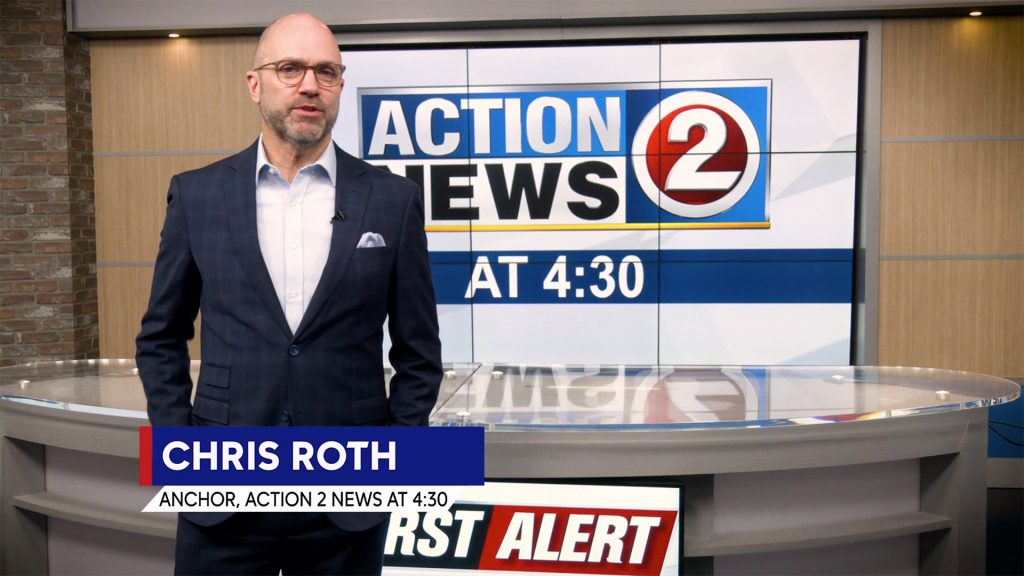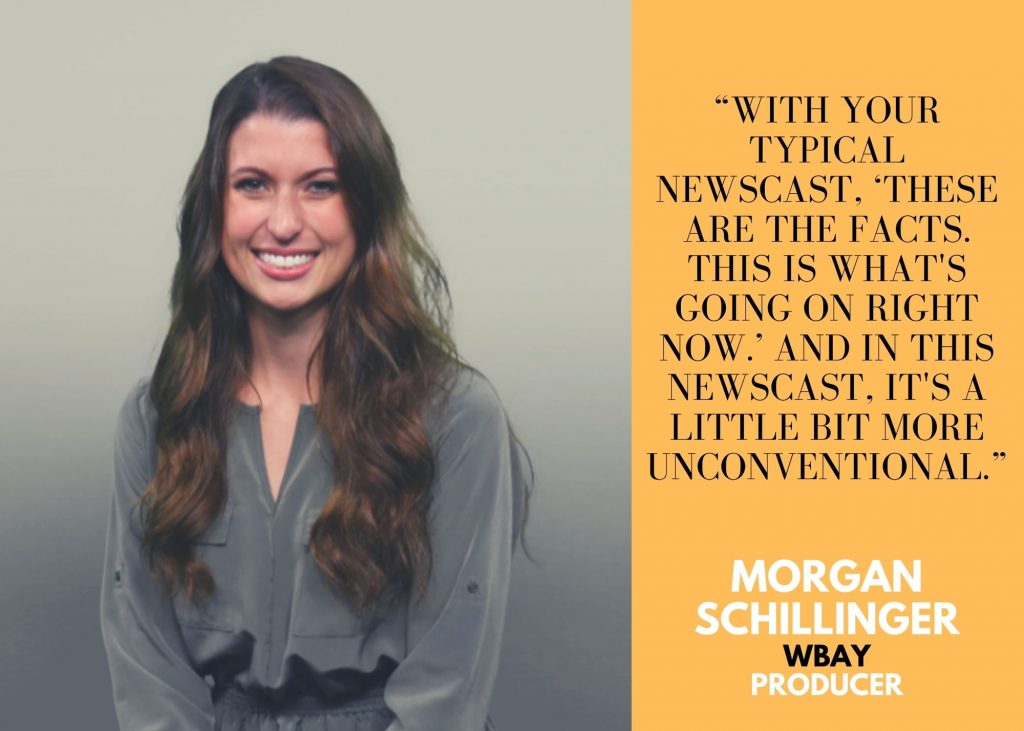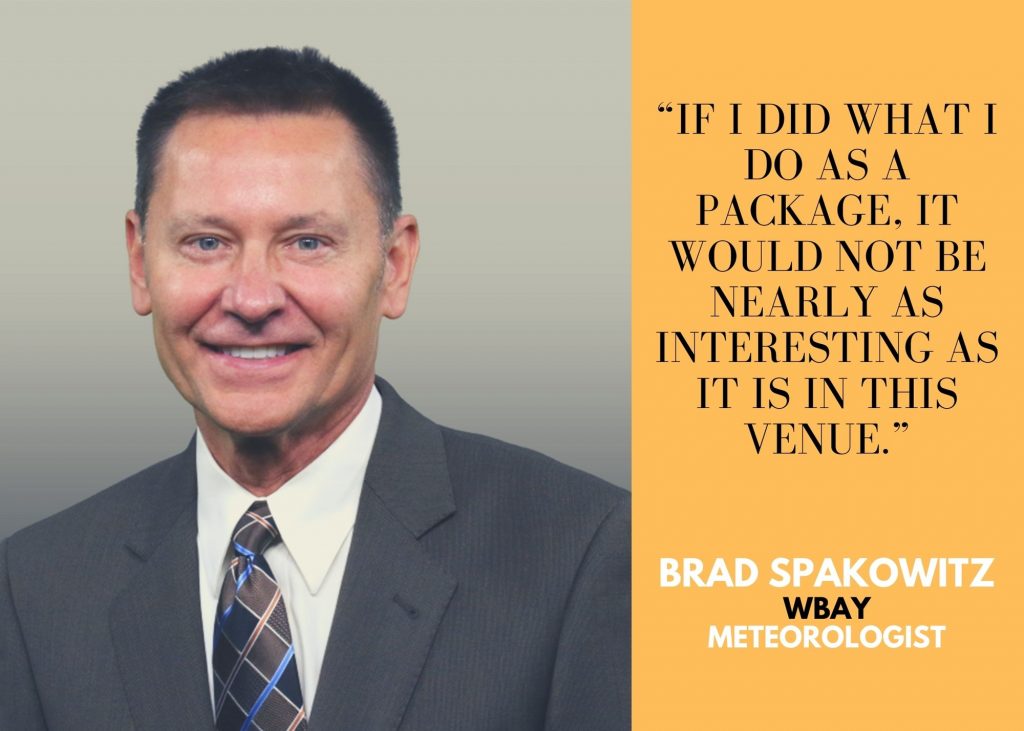
Can a spider weave a web in zero gravity?
If you know the answer, you’re either an arachnologist, a space buff, or perhaps just a viewer of WBAY’s new 4:30 p.m newscast in Green Bay, Wisconsin.
Spiders in space may not sound like typical local news fare, but that’s by no means the only unusual thing about the program, an impressive example of homegrown innovation created with limited resources and some simple but potent ingredients.
When news director Matt Kummer got word that the Gray-owned ABC affiliate would need to add a half-hour newscast to replace Family Feud at 4:30, his first reaction was to round up the usual suspects, including sports director Chris Roth.
“The first word that came to me was Matt pulling me into his office and saying, ‘We’re gonna add another newscast, and we’re probably going to need sports help to fill it,’” Roth says. But Roth had other ideas. “He said, ‘Why don’t you do something a little bit different at 4:30?’” Kummer recalls, “and [he] pitched me on an idea that would essentially use the knowledge of our people — our solid journalists, anchors, reporters — to take a more in-depth look at the day’s news.”

To Kummer’s credit, and with the blessing of GM Steve Lavin, he and Roth came up with a starkly different format: just two stories in the A block, built around a live Q & A with the reporters rather than tape packages; a short headline wrap-up in the B block, using still pictures instead of video; an extended interview with a community newsmaker in the C block; and a new segment called “3 Brilliant Minutes,” with meteorologist Brad Spakowitz going well beyond the weather. “It allows us to expand and give more depth and perspective to stories that we wouldn’t normally have the time to do in a conventional newscast,” Roth says.
What about a main anchor? No surprise: Roth told his boss that “I wouldn’t mind branching out and getting into news myself and anchoring this,” Kummer says. Actually, it wasn’t a tough sell. Roth is a veteran of the station — 22 years next month — who is respected for his broad interests. With COVID cutting down on organized sports, travel, and access to the market’s beloved Packers, he was looking for more to do.

So last September, Action 2 News at 4:30 was born. The team modeled the new half-hour, which is sandwiched between two traditional newscasts at 4 and 5, on Roth’s Sunday night football season sports program, which features expert interviews and a loose, conversational style. “There are times where I have to make sure that I know some of the players involved, because I hadn’t followed it closely until recently,” Roth says. “But the format in which we do this suits me: live, off the cuff, constantly interviewing. That’s what I enjoy doing. And that’s what I’ve been doing with our coverage here for 20 years.”
Producer Morgan Schillinger, whom Kummer moved over from the 6 p.m. newscast, writes about 90% of the program — standard practice in Market #67 — with Roth producing and editing the in-depth C block interview. “I think the biggest challenge was probably changing the way that I write, the language of how I write, and I still struggle with it,” Schillinger says. “You know, sometimes Chris will have to just tell me, ‘Be more conversational.’ Because with your typical newscast, ‘These are the facts. This is what’s going on right now.’ And in this newscast, it’s a little bit more unconventional.” Schillinger had to fill in on the 10 p.m. newscast over the holidays, and “it was like riding a bike. But it was weird.”

Kummer admits that all this tinkering with conventional TV news rules didn’t come easily. “Full disclosure: The concept with weather was probably the hardest one to sell me on,” he says. That concept: Unleash meteorologist Spakowitz, a proud geek, to explore and then explain to Chris Roth a wide range of science stories that spark his interest. “That took me a while to get my head around,” Kummer says. “And I relented on it, saying, ‘Okay, just as long as we get some sort of short forecast element in it.’ But then once I saw it actually happen, I was like, ‘Alright, this is cool.’”
“When it was explained to me, I instantly knew what it needed to be,” Spakowitz says.
“If I did what I do as a package, it would not be nearly as interesting as it is in this venue.” Spakowitz already has a longtime franchise called “Astro Extra” to report on events in the night sky and elsewhere in outer space. He now reads for hours looking for just the right topic for his 4:30 segment — something with what he calls the “wow factor.” “People will say to me, ‘I love the science lesson I’m getting everyday with Brad,’” Kummer says. “A lot of it is driven by his own personality, and you can tell that he loves it. He geeks out on it, and it’s fun, it’s infectious.”

Kummer thinks the new realities of TV news production forced by the pandemic may have helped prepare the audience — and his own colleagues — for something different. “Instead of ‘I have to have X amount of stories in my newscast or my A block,’ maybe it’s not really that way anymore,” he says. “Maybe people are digesting it differently. Maybe we were already in the space to think about reinventing ourselves a little bit, because we just had to do it for almost a year now.”
But another key element in WBAY’s 4:30 experiment is that it features longtime station personalities: familiar faces doing somewhat unfamiliar things. Spakowitz, who carries the wonderful title of “severe weather specialist,” has been at the station even longer than Roth — a total of 28 years, in two different stints. (News director Kummer is in his ninth year — not too shabby for that species.) “We’re all veterans, but that also gives us an innate understanding of our market, and perhaps what our viewers will appreciate,” Roth says. “With Brad being here forever, and me being here forever, we have, hopefully, credibility, but we certainly have longevity, and a track record that people follow and hopefully trust to do something that works.”

And because Roth comes from the world of sports, he brings an on-air humility to his news interviews that stands in contrast to the myth of the “omniscient anchor” that exacerbates the formulaic feel of so many newscasts. “I learned this at an early age in this business: It’s really important to know what you don’t know. And don’t act like you do,” Roth says. “So I try and make sure that I don’t say things on the air that I have no idea what I’m talking about. And if I don’t know, I ask.”
“You can look at [the new program] as a bit of a laboratory, if you will, to be able to try different ideas,” Kummer says. And he’s seeing the effects in other newscasts as well. “There’s more willingness [on the part of reporters and anchors] to be able to try different things in terms of their presentation. I don’t think they feel that there’s necessarily ‘the way that we have to do it’ anymore.”
Kummer says reaction to the new program from viewers has been “overwhelmingly positive.” Props to owner Gray for giving its station the freedom to try something new without a lot of second-guessing. No corporate suit had to change at O’Hare and fly to Green Bay to greenlight the idea.

And speaking of flying, that airborne arachnid I mentioned earlier was the star attraction (sorry!) in what Brad Spakowitz calls his favorite segment so far: “the spider that was brought to the International Space Station.” “They wanted to see how the spider behaves in zero gravity,” Spakowitz says. “They found out it could make a web quite well, despite the lack of gravity. The problem the spider had was it couldn’t figure out where the top of the web was. And that’s where spiders live: They live at the top of the web so they can pounce down on their prey. Well, they discovered that if you introduce a light source into the spider’s vicinity, the spider automatically assumes that that’s the top of the web. So even when you move the light, the spider moves his position. The takeaway is: ‘Show me where the sun is,’ said the little spider. ‘I’ll figure out which is up and which is down.’”
It’s not a bad metaphor for innovation in local TV news. Escape the gravitational pull of conventional formulas, build what you do best, and find the light.
Get the Lab Report: The most important stories delivered to your inbox